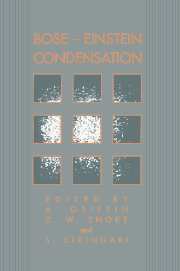Book contents
- Frontmatter
- Contents
- Preface
- Preface to paperback edition
- 1 Introduction: Unifying Themes of Bose–Einstein Condensation
- Part one Review Papers
- Part two Brief Reports
- 20 BEC in Ultra-cold Cesium: Collisional Constraints
- 21 BEC and the Relaxation Explosion in Magnetically Trapped Atomic Hydrogen
- 22 Quest for Kosterlitz–Thouless Transition in Two-Dimensional Atomic Hydrogen
- 23 BEC of Biexcitons in CuCl
- 24 The Influence of Polariton Effects on BEC of Biexcitons
- 25 Light-Induced BEC of Excitons and Biexcitons
- 26 Evolution of a Nonequilibrium Polariton Condensate
- 27 Excitonic Superfluidity in Cu2O
- 28 On the Bose–Einstein Condensation of Excitons: Finite-lifetime Composite Bosons
- 29 Charged Bosons in Quantum Heterostructures
- 30 Evidence for Bipolaronic Bose-liquid and BEC in High-Tc Oxides
- 31 The Dynamic Structure Function of Bose Liquids in the Deep Inelastic Regime
- 32 Possibilities for BEC of Positronium
- 33 Bose–Einstein Condensation and Spin Waves
- 34 Universal Behaviour within the Nozières–Schmitt-Rink Theory
- 35 Bound States and Superfluidity in Strongly Coupled Fermion Systems
- 36 Onset of Superfluidity in Nuclear Matter
- Appendix. BEC 93 Participant List
- Index
21 - BEC and the Relaxation Explosion in Magnetically Trapped Atomic Hydrogen
Published online by Cambridge University Press: 15 December 2009
- Frontmatter
- Contents
- Preface
- Preface to paperback edition
- 1 Introduction: Unifying Themes of Bose–Einstein Condensation
- Part one Review Papers
- Part two Brief Reports
- 20 BEC in Ultra-cold Cesium: Collisional Constraints
- 21 BEC and the Relaxation Explosion in Magnetically Trapped Atomic Hydrogen
- 22 Quest for Kosterlitz–Thouless Transition in Two-Dimensional Atomic Hydrogen
- 23 BEC of Biexcitons in CuCl
- 24 The Influence of Polariton Effects on BEC of Biexcitons
- 25 Light-Induced BEC of Excitons and Biexcitons
- 26 Evolution of a Nonequilibrium Polariton Condensate
- 27 Excitonic Superfluidity in Cu2O
- 28 On the Bose–Einstein Condensation of Excitons: Finite-lifetime Composite Bosons
- 29 Charged Bosons in Quantum Heterostructures
- 30 Evidence for Bipolaronic Bose-liquid and BEC in High-Tc Oxides
- 31 The Dynamic Structure Function of Bose Liquids in the Deep Inelastic Regime
- 32 Possibilities for BEC of Positronium
- 33 Bose–Einstein Condensation and Spin Waves
- 34 Universal Behaviour within the Nozières–Schmitt-Rink Theory
- 35 Bound States and Superfluidity in Strongly Coupled Fermion Systems
- 36 Onset of Superfluidity in Nuclear Matter
- Appendix. BEC 93 Participant List
- Index
Summary
Abstract
We predict and analyze non-trivial relaxational behavior of magnetically trapped gases near the Bose condensation temperature Tc. Due to strong compression of the condensate by the inhomogeneous trapping field, particularly at low densities, the relaxation rate shows a strong, almost jump wise, increase below Tc. As a consequence the maximum fraction of condensate particles is limited to a few percent. This phenomenon can be called a “relaxation explosion”. We discuss its implications for the detectability of BEC in atomic hydrogen.
Magnetostatic traps offer the possibility to study gases of Bose particles in the truly dilute limit, and have proved particularly fruitful [1, 2, 3, 4, 5] in the study of atomic hydrogen (H). In these traps, proposed for H by Hess [6], the effective elimination of physical boundaries is accomplished by creating a magnetic field minimum in free space. This minimum forms a potential well for electron spin-up polarized atoms (H↑), called low-field seekers. The occurrence of Bose–Einstein condensation (BEC) in such systems introduces qualitatively different behavior from the case of a homogeneous Bose gas. This is related to the explosive increase of the dipolar relaxation rate associated with the strong compression of the condensate in an external potential.
- Type
- Chapter
- Information
- Bose-Einstein Condensation , pp. 472 - 477Publisher: Cambridge University PressPrint publication year: 1995

